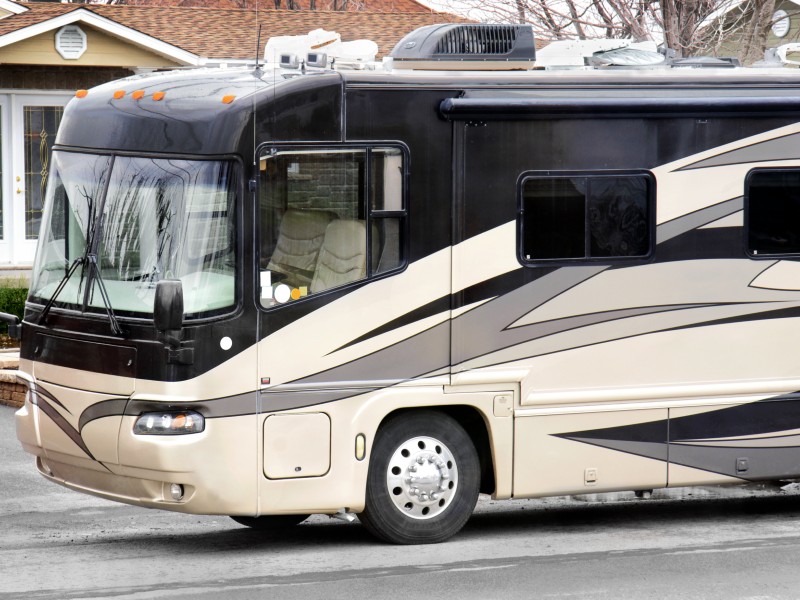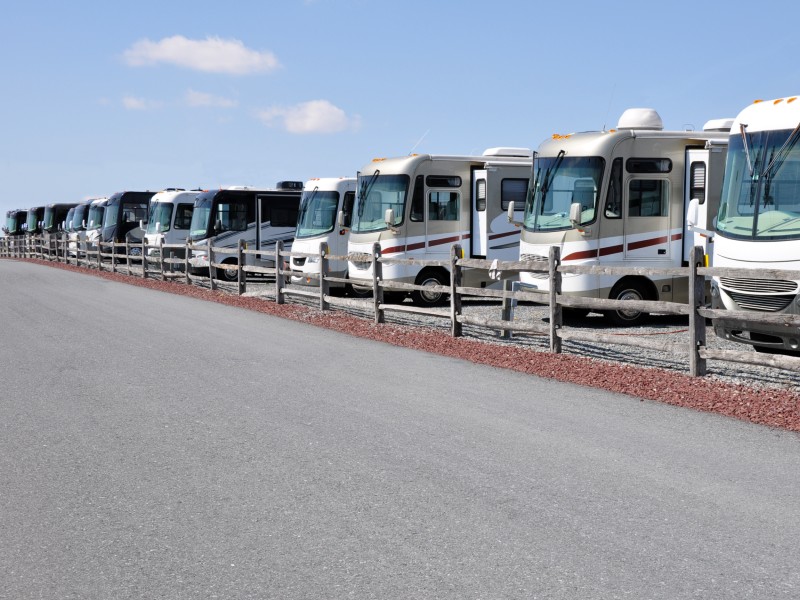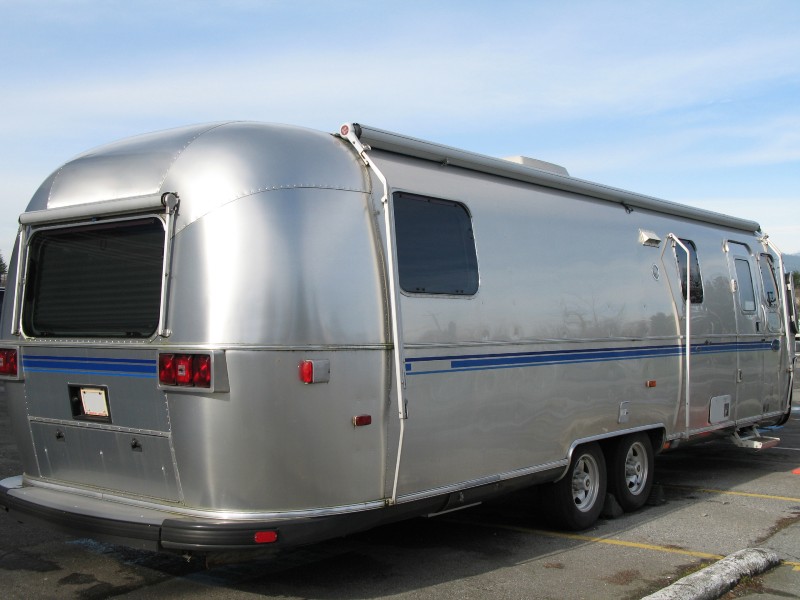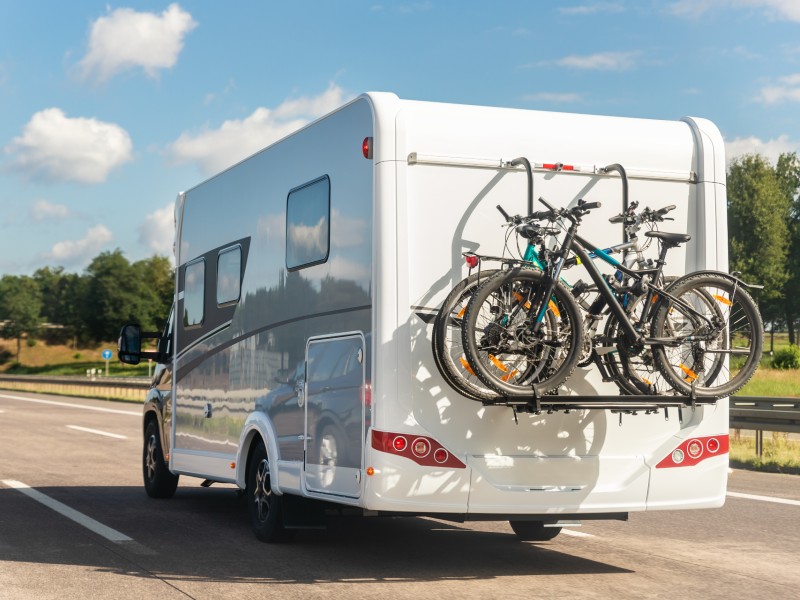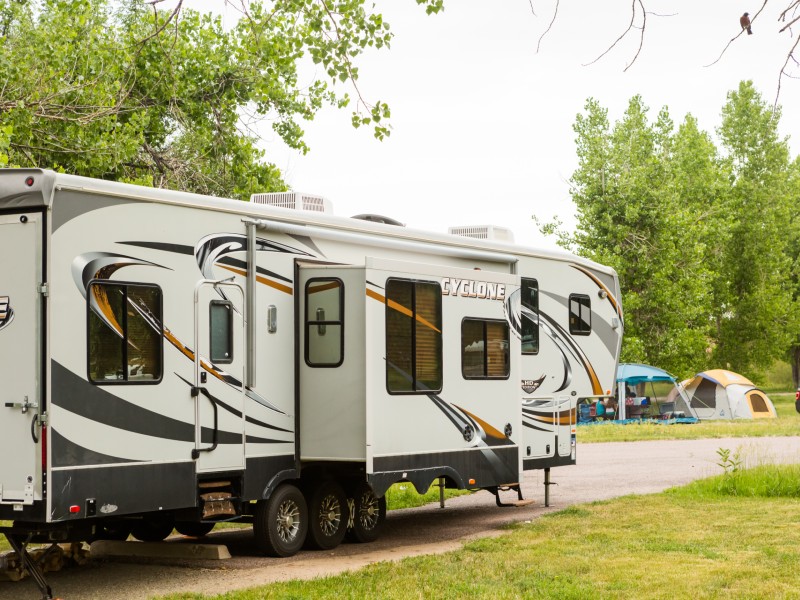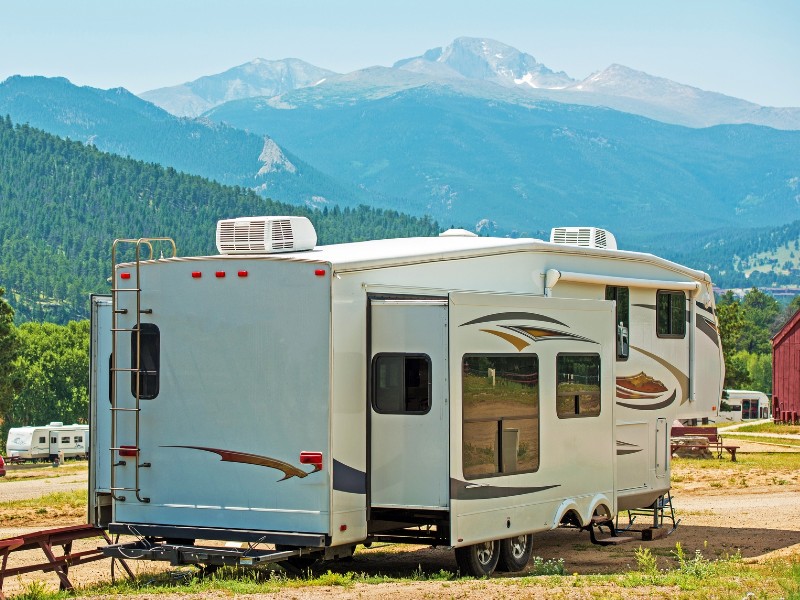RVing can turn into an expensive nightmare if your camper has problem after problem. Here are a few RV brands to dismiss. It’s possible to get stuck with a lemon RV from faulty wiring, cheap materials, bad appliances, poor construction, or horrible floorplans.
After years of RVing across the nation, we’ve personally seen and heard many of these issues while meeting other campsite guests. It’s amazing how certain camper brands have more problems than others.
So, if you’re actively looking for a recreational vehicle, don’t do anything before reading this article on which RV brands to avoid and why.
Before we begin, let’s clarify that not all models within an RV brand line are bad, and many happy campers own a recreational vehicle from the companies below.
We highlight these RV brands to stay away from because of the overall number of complaints, recalls, or other issues like poor design that owners find frustrating.
We also need to mention that nearly all RVs, no matter how expensive, will have things shake loose during the first year or so of travel. This list isn’t going to nitpick RV brands with minor issues that are quick and easy to fix.
#1/8: Fleetwood
Fleetwood is notorious for sloppy craftsmanship and inferior materials going into their camper builds over the last few years.
What was once a top choice for RV buyers, Fleetwood is falling quickly into the camper brand to avoid for annoying and constant issues with:
- Trim work popping loose
- Cheap upholstery that quickly stains and tears
- Wiring faults
- Uneven underlayment
- Delamination of walls, countertops, flooring
- Seam separation
We have taken the “tour” of many Fleetwood RVs during our travels. It’s almost certain that owners will point out all the flaws and repair work they had to take care of themselves even though they bought the new camper right off the showroom floor.
A recurring theme from customer reviews is that fans and lights quit working, and there’s a lack of glue and nails going into keeping trim and woodwork together.
It also doesn’t help that a lot of particleboard goes into the construction of cabinetry and walls. The material under even a little bit of water exposure quickly leads to swelling that is impossible to fix without replacing the whole panel.
One owner couldn’t stop mentioning how the brand and customer service he once found reliable have gone downhill. He said trying to get repairs done under warranty was a complete runaround and felt he practically rebuilt the camper himself.
Unless you’re buying an older Fleetwood from the early 90s or before, you should probably skip this brand entirely, but especially these models:
- Fleetwood Discovery
- Fleetwood Bounder
- Fleetwood Tioga
#2/8: Thor Motorcoach
The Thor motorhome is one of the 8 RV brands that have been having problems keeping customers happy, and you should avoid these. It’s primarily due to many parts recalls that make owners nervous about road trips.
The company is known for installing salvaged or reconditioned parts into new campers to save on costs that obviously won’t have the lifespan of a new component.
We have seen these issues on Thor Class A RVs:
- Leaky hydraulic jacks
- Battery charging issues
- Faulty parking brakes
- 12-volt appliance issues
- Recalls on many parts
- Poor interior upholstery quality
- Awning problems
We have to admit that Thor puts out some nice-looking campers, but the appeal is only skin deep.
We met one owner who found out the hard way the warranty was supported for more cosmetic repairs but wasn’t such a breeze when the water heater broke down.
Thor has had over 50 recalls over the years, so bypass this brand if possible, but especially these Class A motorhome models:
- Thor A.C.E.
- Thor Windsport
- Vegas RUV
#3/8: Forest River
Forest River quality and service have taken a nosedive over the last decade, with no end to the complaints and bad reviews from disappointed or downright angry customers who fell for the efficient floorplan and design.
We had one campground guest invite us into their Salem Cruise Lite travel trailer to enjoy their wonky floor that the company refused to fix. The underlayment quickly went soft in some spots and swelled up in others from water coming through leaky roof seals that ran between the walls going undetected.
Here are the top issues found with Forest River campers:
- Leaky roof due to bad caulking
- Seals around slides deteriorate quickly
- Water lines tend to leak
- The furnace and water heater break down
- Sloppy finish work and popping trim
Some owners tell us that they have no problem getting repairs made by the company, but the constant need to derail camping plans to complete the work is a huge hassle that makes them regret buying a Forest River product.
Here are the top models to avoid:
- Forest River Wildwood
- Forest River Salem Cruise Lite
- Forest River Cherokee Grey Wolf
#4/8: Gulfstream
Gulfstream is another RV brand that has fallen from being a quality camper to one that current owners say to avoid.
Leaks are the most common customer complaint, leading to mold growth and framing damage that can ruin the camper quickly if not fixed correctly.
One person told us that camping trips became stressful whenever rain was in the forecast. They never knew where they would locate a new leak and what damage would occur.
But leaks aren’t the only concern. Here are other issues with Gulfstream RVs:
- Latches on doors and compartments popping open
- Faulty thermostats
- Extreme condensation issues on windows and ceilings
- Wiring issues
- Cheap materials that wear or break quickly
- Appliances or furniture not fully secure/loose screws
Other people complain that the electrical system is unreliable, and things like the leveling jacks often malfunction or lights flicker.
The odd part about Gulfstream is that about half of their camper models get high ratings, while the other half are terrible.
Here are specific Gulfstream camper models to stay away from:
- Gulf Stream Ameri-Lite
- Gulf Stream Kingsport
- Gulf Stream BT Cruiser
#5/8: Coachmen
Coachmen is an oldie but no longer a goodie. New RV models are put together so poorly that the vibrations and bumps of road travel quickly cause annoying wear and tear, with some damage needing very serious repair work.
As Forest River bought out the company, this lack of craftsmanship and attention to detail in current models makes more sense.
We had one camping neighbor spend a good part of one day recaulking seams on his Ameri-Lite travel trailer that split open from the combination of towing stress and weather.
Here are the biggest issues with Coachmen RVs:
- Broken furniture or cabinetry
- Faulty wiring
- Continual leakage
- Low-quality materials
- Poor construction and sagging ceiling panels
- Failing appliances
When taking the camper in for water-leak repairs under warranty, some customers state that Gulfstream only wants technicians to seal up the cracks but do nothing to replace damaged joists or paneling.
Try to avoid these Coachmen models:
- Coachmen Freedom Express
- Coachmen Brookstone
- Coachmen Chaparral
- Coachmen Prism
#6/8: Keystone
Thor took over Keystone, and the manufacturing of these recreational vehicles is of much lower quality than they were pre-2000s.
Customers initially love the floorplan and design in Keystone RVs, but after a year or so are tired of nagging problems such as electronic or electrical system bugs that often mean sensors won’t read correctly or the fridge won’t work.
Here are the big concerns with Keystone RVs:
- Cheap materials in furniture or cabinetry
- Glitchy wiring
- Air leakage from unsealed holes around pipes
- Carpet that mats down quickly
- Poor response from customer service
We took a look around some Keystone RVs at a showroom and, after some close inspection, found that cabinets were pressboard with thin veneers that won’t hold up to the demands of active camper use. Trim work wasn’t very neat, and only a few staples seemed to secure it in place.
Bypass these Keystone models:
- Keystone Montana High Country
- Keystone Hideout
- Keystone Cougar
Explore the Great Outdoors with Us!
#7/8: Winnebago
Winnebago has both hits and misses, so tread carefully when shopping this RV brand. Some models are notorious for poor construction, leading to delamination of interior and exterior walls and siding, so they appear wavy.
We had one camping friend show us his “new” Minnie after a week-long trip that had one siding panel so loose it was a miracle it didn’t blow off while driving.
Whether this delamination problem was a batch of bad glue or poor workmanship during manufacturing is hard to detect, but reattaching exterior siding on a camper is no easy feat.
Here are other top concerns with Winnebago RVs:
- Electrical/wiring issues – especially lights
- Uninspiring and poor-functioning interior design
- Badly fitting trim, furniture, and appliances
- Engine problems and a bumpy ride
- Warranty repair issues
Customers note that they often need to spend time nailing down trim or tightening up screws. They have to be careful moving camping gear in and out to avoid nicking or denting low-quality interior and exterior components.
Another item to pay attention to is that owners find Winnebago overstates the reality of how many people can comfortably fit inside while camping. If a camper model says there are sleeping quarters for six, most likely, it’s going to be a very tight and highly uncomfortable fit.
Consider moving past these Winnebago models:
- Winnebago Vista
- Winnebago Minnie Winnie
- Winnebago Era
#8/8: Coleman
Coleman rounds out the list of the 8 RV brands to stay away from and avoid, even if the name is highly recognizable for quality camping equipment and supplies.
By jumping into the RV market to take advantage of the Coleman name, the designers didn’t do enough homework to provide a durable camper with user-friendly layouts and amenities.
We got the pleasure of meeting a Coleman camper-owning couple who said their RV had a laundry list of issues with plumbing, electrical, and finish work, and they couldn’t wait to trade it in for a different brand.
Here are the problems common in Coleman RVs:
- Loose wiring
- Toilets and showers malfunctioning
- Issues with appliances breaking down
- Fading and cracks in exterior siding and decals
- Poor foot traffic and functionality
Coleman does offer one of the most extended warranties in the RV industry and prices their campers affordably, but don’t let this lure you into making a wrong purchase.
Skip these Coleman campers with the lowest ratings from customers:
- Coleman Light
- Coleman Lantern
- Coleman Explorer
Ways to Avoid Buying a Money-pit RV
Along with reading articles like this about which recreational vehicle brands or models you need to avoid, you can also increase RV shopping success by:
- Inspecting potential RV purchases with a keen eye
- Look for a used camper
- Do your own research
Once you see an RV you like, start opening cabinets and compartments to inspect the quality of wood and any electrical or plumbing connections you can see. Look at the exterior seams (climb on that roof, too) for split or incomplete caulking and how well the interior trim is attached.
If you spot little things wrong, chances are the big things are also not up to par.
Looking at used RVs has two benefits for potential buyers. The first is that the previous owner will, by this point, have fixed all the little “quirks” most RVs have.
The second is that you can see exactly how well the furnishings and appliances hold up after years of use. If the camper is three years old and the carpet, countertops, and upholstery shows wear, you know the materials are of poor quality.
So if you have a new camper on your list of a particular brand, see if you can find a used model for comparison.
Remember, if you’re looking for a good reliable RV, you’ll want to read this article on the best class A RVs.
Lastly, don’t skimp on personal research when RV shopping. Set aside a few hours to search online for ratings and reviews from owners of the brands that interest you.
The more you know about the 8 RV brands stores have to sell, the easier it’ll be to make the right choice knowing which ones to avoid. that will bring you years of camping enjoyment!
Pathetic Quality! It’s a Disgrace!
Related Questions
- What are some common issues that RV owners face with Fleetwood models, and how can they be avoided?
Common issues that Fleetwood RV owners often face include electrical problems, such as issues with the solar charging system, and potential inconsistencies with the voltage readings.
Regular maintenance checks, ensuring the solar panel is receiving adequate sunlight, and keeping the batteries in good condition can help avoid these problems.
- How has the quality of Thor Motorcoach RVs changed over the years, and what are the most common complaints from customers?
The quality of Thor Motorcoach RVs has varied over the years, with some customers praising their RVs for their liveability and floorplan, while others have criticized the overall quality and factory warranty.
The most common complaints from customers include issues with the build and component quality, problems with large slide-outs, and dissatisfaction with the warranty service.
- What are the top issues found with Forest River campers, and how can potential buyers identify these problems before purchasing?
The top issues found with Forest River campers often include poor build quality leading to leaks, electrical issues, and structural problems.
Potential buyers can identify these problems before purchasing by conducting a thorough inspection of the camper, including checking for signs of water damage, testing all electrical systems, and inspecting the structural integrity of the camper, preferably with the help of a professional.
- What are some strategies for avoiding the purchase of a problematic RV, and how can potential buyers conduct effective research before making a purchase?
To avoid purchasing a problematic RV, potential buyers should conduct thorough research on the model’s reliability, check for recalls, and consider hiring a certified RV inspector for a detailed examination.
Additionally, they can leverage online resources such as RV forums, reviews, and consumer reports to gather insights about the RV’s performance, maintenance history, and overall satisfaction from previous owners.
"Of all the paths you take in life, make sure a few of them are dirt."
-- John Muir
